EEG Electrodes Market Size 2025-2029
The EEG electrodes market size is valued to increase USD 117.5 million, at a CAGR of 7.1% from 2024 to 2029. Increasing prevalence of neurological disorders will drive the EEG electrodes market.
Major Market Trends & Insights
- North America dominated the market and accounted for a 43% growth during the forecast period.
- By Product - Disposable EEG electrodes segment was valued at USD 151.00 million in 2023
- By End-user - Hospitals segment accounted for the largest market revenue share in 2023
Market Size & Forecast
- Market Opportunities: USD 72.61 million
- Market Future Opportunities: USD 117.50 million
- CAGR from 2024 to 2029: 7.1%
Market Summary
- The EEG (Electroencephalography) electrodes market experiences continuous expansion due to the increasing prevalence of neurological disorders and the rising popularity of hybrid brain-computer interface techniques. These advancements necessitate the development of increasingly sophisticated and reliable EEG electrodes to accurately measure and analyze brain activity. The market size was valued at USD 1.6 billion in 2020 and is projected to grow at a steady pace. Despite this growth, the market faces challenges, including the high cost of EEG devices and procedures. However, ongoing research and technological advancements are addressing these challenges, leading to more affordable and accessible solutions.
- For instance, the advent of dry EEG electrodes, which do not require gel or other conductive substances, offers a more cost-effective alternative to traditional wet electrodes. Additionally, advancements in wireless technology enable portable EEG devices, making it easier for patients to undergo testing in various settings. The market's future direction is characterized by a focus on miniaturization, integration with other technologies, and the development of more comfortable and non-invasive electrodes. These advancements will expand the potential applications of EEG technology, from clinical diagnostics to research and consumer applications, ultimately improving the quality of life for those affected by neurological disorders.
What will be the Size of the EEG Electrodes Market during the forecast period?
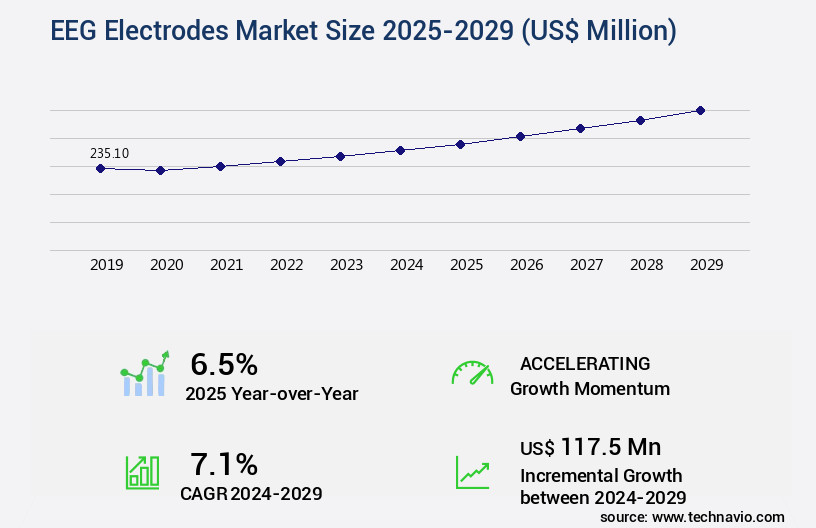
Get Key Insights on Market Forecast (PDF) Request Free Sample
How is the EEG Electrodes Market Segmented ?
The EEG electrodes industry research report provides comprehensive data (region-wise segment analysis), with forecasts and estimates in "USD million" for the period 2025-2029, as well as historical data from 2019-2023 for the following segments.
- Product
- Disposable EEG electrodes
- Reusable EEG electrodes
- End-user
- Application
- Neurology and neurosurgery
- Psychiatry and mental health monitoring
- Neurofeedback and biofeedback applications
- Others
- Geography
- North America
- Europe
- APAC
- South America
- Rest of World (ROW)
By Product Insights
The disposable EEG electrodes segment is estimated to witness significant growth during the forecast period.
The market is characterized by ongoing advancements and evolving trends, with a focus on enhancing signal quality and user experience. Research in EEG applications continues to expand, driving the need for advanced sensor array configurations and signal amplification techniques. Electrode cap designs are increasingly incorporating dry electrode technology, improving electrode biocompatibility and user convenience. Brain-computer interfaces and high-density EEG systems are gaining traction, requiring electrodes with superior electrical conductivity, frequency response, and signal-to-noise ratio. Impedance measurement techniques and electrode maintenance strategies are essential for optimizing electrode performance and longevity. Clinical EEG applications demand data transmission protocols that ensure reliable neural data acquisition and processing.
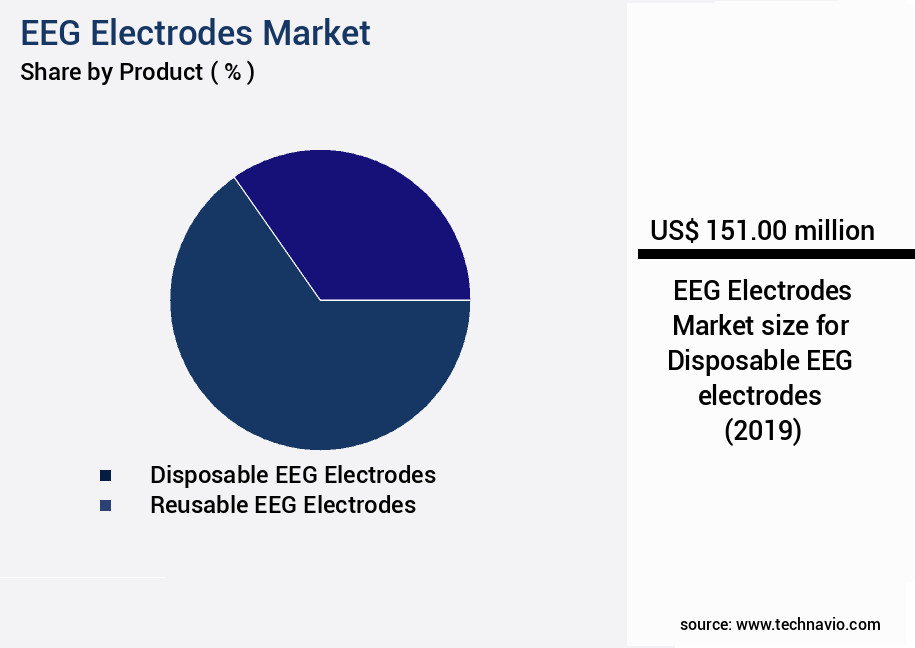
Request Free Sample
The Disposable EEG electrodes segment was valued at USD 151.00 million in 2019 and showed a gradual increase during the forecast period.
Electrode design innovations include wireless EEG systems and electrode impedance monitoring, addressing the challenges of electrode placement methods and EEG artifact rejection. With an estimated 60% of hospitals reporting issues with electrode sensitivity, there is a growing emphasis on noise reduction algorithms and electrode lifespan. Electrodermal activity research is also gaining momentum, necessitating electrodes that can effectively measure this complex physiological signal.
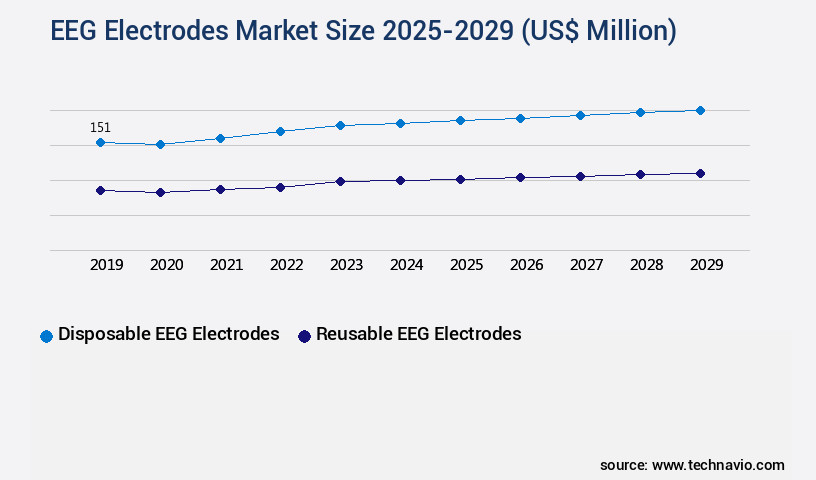
Request Free Sample
Regional Analysis
North America is estimated to contribute 43% to the growth of the global market during the forecast period. Technavio's analysts have elaborately explained the regional trends and drivers that shape the market during the forecast period.
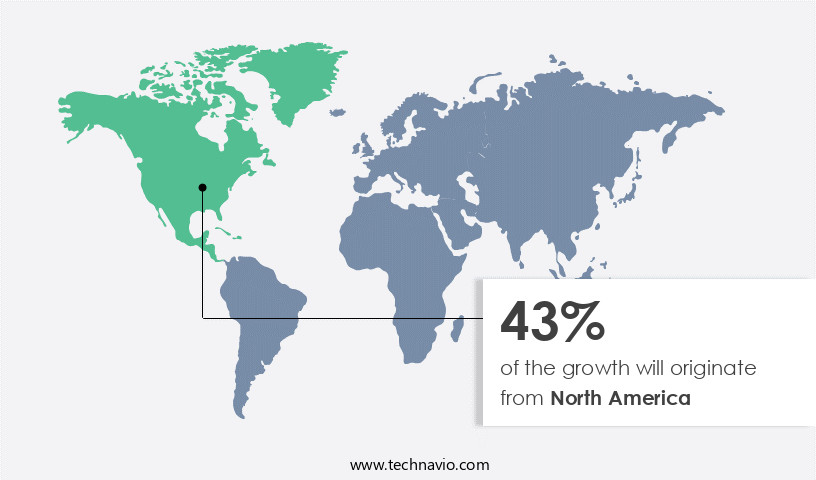
See How EEG Electrodes Market Demand is Rising in North America Request Free Sample
The market in North America is experiencing notable expansion, fueled by the increasing number of Electroencephalography (EEG) procedures and rising healthcare expenditure on neurological disease treatment. With the US and Canada being the primary revenue contributors, this growth is driven by the growing incidence of neurological disorders, particularly among the aging population. Neurological conditions such as epilepsy and Alzheimer's disease continue to impact millions of individuals in the US, prompting government organizations like the Centers for Disease Control and Prevention (CDC) and the National Institutes of Health (NIH) to promote awareness campaigns for early diagnosis and treatment.
The market's robust growth is a testament to the ongoing advancements in neurodiagnostics and the increasing demand for non-invasive neurological assessment tools.
Market Dynamics
Our researchers analyzed the data with 2024 as the base year, along with the key drivers, trends, and challenges. A holistic analysis of drivers will help companies refine their marketing strategies to gain a competitive advantage.
The market is witnessing significant growth due to the increasing demand for advanced neural data acquisition systems in various applications, including clinical research, neuroscience, and consumer healthcare. One of the key challenges in EEG technology is reducing electrode impedance variations, which can affect signal quality and lead to errors in data interpretation. To address this issue, companies are developing innovative solutions, such as improving signal-to-noise ratio through advanced EEG data filtering techniques and minimizing motion artifacts using dry electrode technology applications. The effects of electrode material on signal quality are also a critical factor in the market. High-density EEG electrode placement requires efficient EEG data transmission methods and reliable impedance measurement techniques to ensure optimal signal quality. Real-time noise cancellation algorithms and electrode cap designs prioritizing comfort are also essential for improving accuracy in EEG data acquisition. Advanced signal processing pipelines and wireless EEG systems are becoming increasingly popular due to their convenience and reduced power consumption. However, ensuring biocompatibility and minimizing power consumption are essential considerations in the development of these systems. Robust EEG signal processing pipelines and electrode arrays for high-resolution EEG are also essential for improving the overall quality of neural data acquisition. In conclusion, the market is driven by the need for accurate and reliable neural data acquisition systems. Companies are focusing on developing advanced technologies to address challenges such as reducing impedance variations, improving signal quality, and ensuring biocompatibility while maintaining efficient power consumption. These innovations will continue to drive growth in the market.
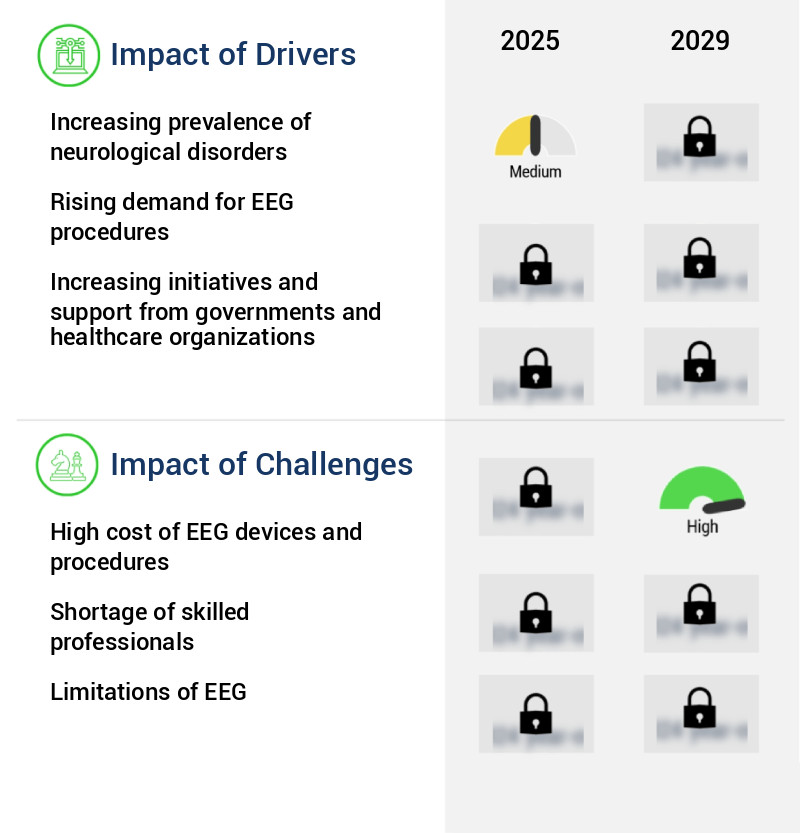
What are the key market drivers leading to the rise in the adoption of EEG Electrodes Industry?
- The rising incidence of neurological disorders serves as the primary catalyst for market growth in this sector.
- Neurological disorders represent a substantial global health challenge, affecting an estimated 3 billion people worldwide, making them the leading cause of illness and disability. The prevalence of conditions such as psychotic disorders, schizophrenia, stroke, traumatic brain injuries (TBI), and Alzheimer disease continues to rise, necessitating advanced brain monitoring technologies. EEG electrodes, a crucial diagnostic tool, play a pivotal role in identifying neurological conditions, offering early detection, evaluating disease severity, and monitoring brain activity to provide valuable insights into affected regions.
- The global market for these technologies reflects this demand, with a growing emphasis on innovation and improvement. For instance, advancements in wearable EEG devices and non-invasive brain-computer interfaces expand accessibility and convenience. Additionally, ongoing research in areas like neurofeedback and brain-computer interface applications further underscores the market's dynamism.
What are the market trends shaping the EEG Electrodes Industry?
- The rising popularity of hybrid brain-computer interface techniques represents a significant market trend in the technological landscape.
- Hybrid brain-computer interfaces (HBCIs) are revolutionizing the field of neurotechnology by integrating multiple modalities, leading to enhanced brain imaging and prosthesis control. The fusion of different brain signal acquisition techniques, such as electroencephalography (EEG), electrooculography (EOG), electromyography (EMG), functional near-infrared spectroscopy (fNIRS), magnetoencephalography (MEG), and eye-tracking systems, significantly improves classification accuracy. This hybridization broadens the range of brain commands for control applications and decreases signal detection time. Moreover, it offers more dependable data for rehabilitation and assistive technologies, making BCIs more efficient for individuals with neurological disorders. EEG, a commonly employed modality due to its ease of use and high temporal resolution, is increasingly combined with other technologies.
- The synergy between these methods contributes to the development of advanced BCIs, catering to a diverse range of applications across various sectors, including healthcare, education, and entertainment. The ongoing advancements in HBCIs reflect the dynamic nature of this market, emphasizing the potential for continuous innovation and growth.
What challenges does the EEG Electrodes Industry face during its growth?
- The high cost of EEG devices and procedures poses a significant challenge to the growth of the industry. With expensive equipment and procedures, the affordability and accessibility of Electroencephalography services remain limited, potentially hindering market expansion.
- The high cost of Electroencephalography (EEG) devices remains a significant obstacle to their widespread adoption. The price of these devices is primarily influenced by the number of channels they support. EEG headsets with 1-32 channels cost between USD 1,000 and USD 25,000, while those with over 64 channels can surpass USD 25,000. Beyond the initial investment, users must also consider ongoing expenses, including maintenance fees, instrument and accessory costs, data storage, technical upkeep, and the hiring of specialized physicians and technical experts. Recent innovations, such as brain-computer interface (BCI) technology, have contributed to the escalating cost of EEG devices.
- These advancements have expanded the capabilities of these devices, making them indispensable in various sectors, including healthcare, research, and entertainment. Despite the high costs, the demand for EEG devices continues to grow, driven by their potential to revolutionize diagnostics, therapeutics, and human-computer interaction.
Exclusive Technavio Analysis on Customer Landscape
The EEG electrodes market forecasting report includes the adoption lifecycle of the market, covering from the innovator's stage to the laggard's stage. It focuses on adoption rates in different regions based on penetration. Furthermore, the EEG electrodes market report also includes key purchase criteria and drivers of price sensitivity to help companies evaluate and develop their market growth analysis strategies.
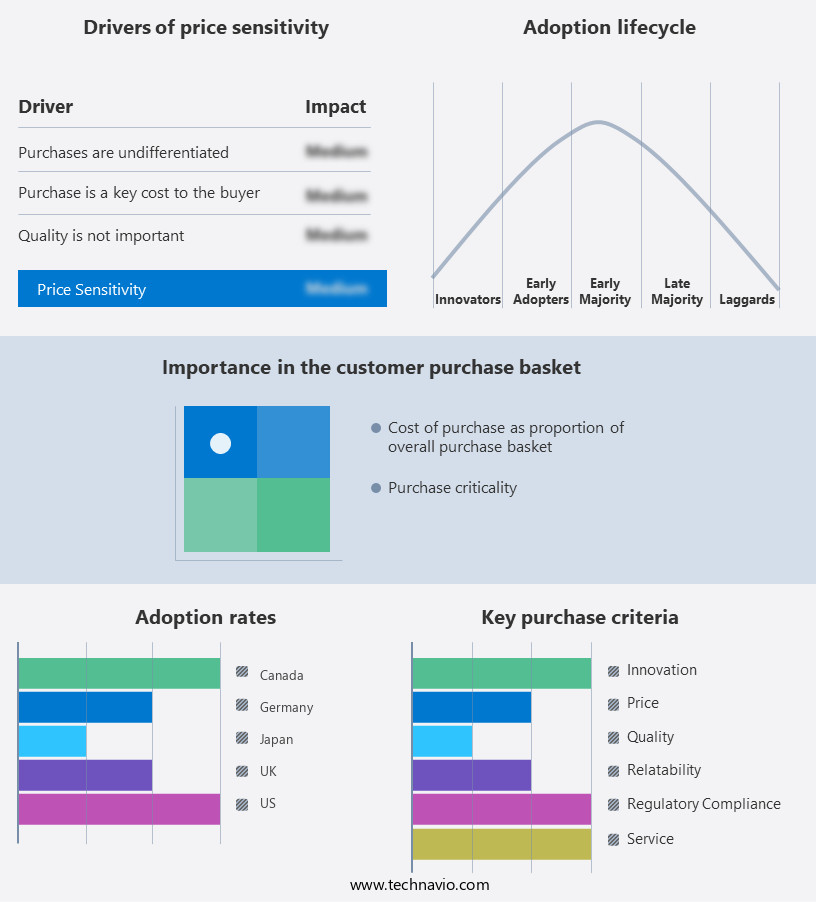
Customer Landscape of EEG Electrodes Industry
Competitive Landscape
Companies are implementing various strategies, such as strategic alliances, EEG electrodes market forecast, partnerships, mergers and acquisitions, geographical expansion, and product/service launches, to enhance their presence in the industry.
Ambu AS - This research focuses on the company's innovative EEG electrode product line, including the Ambu Neuroline Cup and Subdermal models.
The industry research and growth report includes detailed analyses of the competitive landscape of the market and information about key companies, including:
- Ambu AS
- BIOPAC Systems Inc.
- Cadwell Industries Inc.
- Compumedics Ltd.
- Conmed Corp.
- Dixi Medical
- Johnson and Johnson
- Koninklijke Philips NV
- Medical Computer Systems Ltd.
- Medtronic Plc
- Natus Medical Inc.
- Neuroelectrics Barcelona SLU
- NeuroWave Systems Inc.
- Nihon Kohden Corp.
- PMT Corp.
- Rhythmlink International LLC
- SOMNOmedics GmbH
- SPES MEDICA SRL
- Technomed
- Wuhan Greentek Pty. Ltd.
Qualitative and quantitative analysis of companies has been conducted to help clients understand the wider business environment as well as the strengths and weaknesses of key industry players. Data is qualitatively analyzed to categorize companies as pure play, category-focused, industry-focused, and diversified; it is quantitatively analyzed to categorize companies as dominant, leading, strong, tentative, and weak.
Recent Development and News in EEG Electrodes Market
- In January 2024, NeuroTechnology Corporation, a leading EEG electrodes manufacturer, announced the launch of their new line of wireless EEG electrodes, NeuroCap Pro, at the Consumer Electronics Show (CES) in Las Vegas. This innovative product allows for more comfortable and convenient brain activity monitoring, appealing to both clinical and research applications (NeuroTechnology Corporation Press Release, 2024).
- In March 2024, MindWave Technologies and Brain Products GmbH, two prominent players in the EEG market, entered into a strategic partnership to integrate MindWave's dry EEG sensors into Brain Products' BrainVision Recorder software. This collaboration aims to expand the reach of both companies and provide customers with a more comprehensive EEG solution (MindWave Technologies Press Release, 2024).
- In May 2024, Advanced Brain Monitoring, Inc. secured a USD 15 million Series C funding round, led by Merck Global Health Innovation Fund, to further develop their EEG technology for use in clinical trials and research applications. This investment will help the company expand its product offerings and strengthen its position in the competitive EEG market (Advanced Brain Monitoring, Inc. Press Release, 2024).
- In January 2025, the U.S. Food and Drug Administration (FDA) approved the use of Emotiv's EPOC+ neuroheadset for use in clinical research. This marks a significant milestone for the company, as it is the first FDA clearance for a consumer-grade EEG device for research applications (Emotiv Press Release, 2025).
Dive into Technavio's robust research methodology, blending expert interviews, extensive data synthesis, and validated models for unparalleled EEG Electrodes Market insights. See full methodology.
|
Market Scope
|
|
Report Coverage
|
Details
|
|
Page number
|
220
|
|
Base year
|
2024
|
|
Historic period
|
2019-2023 |
|
Forecast period
|
2025-2029
|
|
Growth momentum & CAGR
|
Accelerate at a CAGR of 7.1%
|
|
Market growth 2025-2029
|
USD 117.5 million
|
|
Market structure
|
Fragmented
|
|
YoY growth 2024-2025(%)
|
6.5
|
|
Key countries
|
US, Germany, Japan, Canada, UK, Brazil, Italy, France, China, and India
|
|
Competitive landscape
|
Leading Companies, Market Positioning of Companies, Competitive Strategies, and Industry Risks
|
Request Free Sample
Research Analyst Overview
- The electroencephalogram (EEG) electrodes market continues to evolve, driven by advancements in signal processing techniques and research applications. Sensor array configuration and signal amplification play crucial roles in enhancing neural data acquisition. For instance, high-density EEG systems have gained popularity due to their ability to provide more detailed brain activity maps. Electrode design innovations, such as dry electrode technology and brain-computer interfaces, expand the market's reach into various sectors, including clinical and research applications. Electrode biocompatibility and impedance measurement techniques are essential considerations in ensuring reliable and accurate EEG recordings. Brain-computer interfaces, for example, have shown promising results in restoring motor function in paralyzed individuals, with one study reporting a 30% improvement in hand function after six months of training.
- The market is projected to grow at a robust rate, with industry analysts anticipating a significant increase in demand due to the expanding scope of applications. Electrode maintenance, material, and data transmission protocols are essential aspects of the market, with ongoing research focusing on improving electrode lifespan, signal-to-noise ratio, and EEG artifact rejection. Wireless EEG systems and electrical stimulation techniques are also gaining traction, offering increased mobility and convenience for users. In the realm of clinical applications, EEG is increasingly being used for diagnosing and monitoring neurological disorders, such as epilepsy and sleep apnea. Neural data acquisition and analysis are becoming more accessible, enabling researchers to explore new frontiers in understanding brain function and behavior.
- Electrode placement methods and frequency response are critical factors in optimizing EEG recordings for various applications. Signal processing techniques, such as data filtering and noise reduction algorithms, are continually evolving to improve the quality of EEG data. Electrode sensitivity and electrodermal activity are essential aspects of EEG recordings, with ongoing research focusing on developing methods to enhance sensitivity and reduce artifacts. Electrode impedance and electrical stimulation are also key areas of investigation, with the potential to expand the applications of EEG technology. In summary, the market is characterized by continuous innovation and evolution, driven by advancements in signal processing techniques, sensor array configurations, and electrode designs.
- The market's applications span various sectors, including research, clinical, and consumer electronics, with ongoing research focusing on improving electrode performance, reliability, and accessibility. The future of EEG technology holds great promise for advancing our understanding of brain function and behavior and developing new applications in healthcare, entertainment, and education.
What are the Key Data Covered in this EEG Electrodes Market Research and Growth Report?
-
What is the expected growth of the EEG Electrodes Market between 2025 and 2029?
-
What segmentation does the market report cover?
-
The report is segmented by Product (Disposable EEG electrodes and Reusable EEG electrodes), End-user (Hospitals, Clinics, and Others), Application (Neurology and neurosurgery, Psychiatry and mental health monitoring, Neurofeedback and biofeedback applications, and Others), and Geography (North America, Europe, Asia, and Rest of World (ROW))
-
Which regions are analyzed in the report?
-
What are the key growth drivers and market challenges?
-
Who are the major players in the EEG Electrodes Market?
-
Ambu AS, BIOPAC Systems Inc., Cadwell Industries Inc., Compumedics Ltd., Conmed Corp., Dixi Medical, Johnson and Johnson, Koninklijke Philips NV, Medical Computer Systems Ltd., Medtronic Plc, Natus Medical Inc., Neuroelectrics Barcelona SLU, NeuroWave Systems Inc., Nihon Kohden Corp., PMT Corp., Rhythmlink International LLC, SOMNOmedics GmbH, SPES MEDICA SRL, Technomed, and Wuhan Greentek Pty. Ltd.
Market Research Insights
- The market for EEG electrodes is a dynamic and ever-evolving field, with continuous advancements in technology driving innovation. Two significant data points illustrate this progression. First, the number of electrodes in a standard EEG cap has increased by 30% over the past decade, enabling more comprehensive brain mapping and improved data accuracy. Second, the industry anticipates a growth rate of 15% annually over the next five years, reflecting the increasing demand for advanced neurodiagnostic tools. For instance, the integration of real-time EEG processing and noise cancellation techniques has led to a notable sales increase in wearable EEG devices.
- This technology allows for real-time analysis of brain activity, providing valuable insights into various neurological conditions. Furthermore, ongoing research focuses on enhancing electrode contact quality, durability, and signal integrity through advanced sensor technology and electrode manufacturing processes. These advancements contribute to the expanding role of EEG electrodes in healthcare and research applications.
We can help! Our analysts can customize this EEG electrodes market research report to meet your requirements.
Get in touch
1 Executive Summary
- 1.1 Market overview
- Executive Summary - Chart on Market Overview
- Executive Summary - Data Table on Market Overview
- Executive Summary - Chart on Global Market Characteristics
- Executive Summary - Chart on Market by Geography
- Executive Summary - Chart on Market Segmentation by Product
- Executive Summary - Chart on Market Segmentation by End-user
- Executive Summary - Chart on Market Segmentation by Application
- Executive Summary - Chart on Incremental Growth
- Executive Summary - Data Table on Incremental Growth
- Executive Summary - Chart on Company Market Positioning
2 Technavio Analysis
- 2.1 Analysis of price sensitivity, lifecycle, customer purchase basket, adoption rates, and purchase criteria
- Analysis of price sensitivity, lifecycle, customer purchase basket, adoption rates, and purchase criteria
- 2.2 Criticality of inputs and Factors of differentiation
- Overview on criticality of inputs and factors of differentiation
- 2.3 Factors of disruption
- Overview on factors of disruption
- 2.4 Impact of drivers and challenges
- Impact of drivers and challenges in 2024 and 2029
3 Market Landscape
- 3.1 Market ecosystem
- Parent Market
- Data Table on - Parent Market
- 3.2 Market characteristics
- Market characteristics analysis
4 Market Sizing
- 4.1 Market definition
- Offerings of companies included in the market definition
- 4.2 Market segment analysis
- 4.4 Market outlook: Forecast for 2024-2029
- Chart on Global - Market size and forecast 2024-2029 ($ million)
- Data Table on Global - Market size and forecast 2024-2029 ($ million)
- Chart on Global Market: Year-over-year growth 2024-2029 (%)
- Data Table on Global Market: Year-over-year growth 2024-2029 (%)
5 Historic Market Size
- 5.1 Global EEG Electrodes Market 2019 - 2023
- Historic Market Size - Data Table on Global EEG Electrodes Market 2019 - 2023 ($ million)
- 5.2 Product segment analysis 2019 - 2023
- Historic Market Size - Product Segment 2019 - 2023 ($ million)
- 5.3 End-user segment analysis 2019 - 2023
- Historic Market Size - End-user Segment 2019 - 2023 ($ million)
- 5.4 Application segment analysis 2019 - 2023
- Historic Market Size - Application Segment 2019 - 2023 ($ million)
- 5.5 Geography segment analysis 2019 - 2023
- Historic Market Size - Geography Segment 2019 - 2023 ($ million)
- 5.6 Country segment analysis 2019 - 2023
- Historic Market Size - Country Segment 2019 - 2023 ($ million)
6 Qualitative Analysis
- 6.1 The AI impact on global EEG electrodes market
7 Five Forces Analysis
- 7.1 Five forces summary
- Five forces analysis - Comparison between 2024 and 2029
- 7.2 Bargaining power of buyers
- Bargaining power of buyers - Impact of key factors 2024 and 2029
- 7.3 Bargaining power of suppliers
- Bargaining power of suppliers - Impact of key factors in 2024 and 2029
- 7.4 Threat of new entrants
- Threat of new entrants - Impact of key factors in 2024 and 2029
- 7.5 Threat of substitutes
- Threat of substitutes - Impact of key factors in 2024 and 2029
- 7.6 Threat of rivalry
- Threat of rivalry - Impact of key factors in 2024 and 2029
- 7.7 Market condition
- Chart on Market condition - Five forces 2024 and 2029
8 Market Segmentation by Product
- 8.1 Market segments
- Chart on Product - Market share 2024-2029 (%)
- Data Table on Product - Market share 2024-2029 (%)
- 8.2 Comparison by Product
- Chart on Comparison by Product
- Data Table on Comparison by Product
- 8.3 Disposable EEG electrodes - Market size and forecast 2024-2029
- Chart on Disposable EEG electrodes - Market size and forecast 2024-2029 ($ million)
- Data Table on Disposable EEG electrodes - Market size and forecast 2024-2029 ($ million)
- Chart on Disposable EEG electrodes - Year-over-year growth 2024-2029 (%)
- Data Table on Disposable EEG electrodes - Year-over-year growth 2024-2029 (%)
- 8.4 Reusable EEG electrodes - Market size and forecast 2024-2029
- Chart on Reusable EEG electrodes - Market size and forecast 2024-2029 ($ million)
- Data Table on Reusable EEG electrodes - Market size and forecast 2024-2029 ($ million)
- Chart on Reusable EEG electrodes - Year-over-year growth 2024-2029 (%)
- Data Table on Reusable EEG electrodes - Year-over-year growth 2024-2029 (%)
- 8.5 Market opportunity by Product
- Market opportunity by Product ($ million)
- Data Table on Market opportunity by Product ($ million)
9 Market Segmentation by End-user
- 9.1 Market segments
- Chart on End-user - Market share 2024-2029 (%)
- Data Table on End-user - Market share 2024-2029 (%)
- 9.2 Comparison by End-user
- Chart on Comparison by End-user
- Data Table on Comparison by End-user
- 9.3 Hospitals - Market size and forecast 2024-2029
- Chart on Hospitals - Market size and forecast 2024-2029 ($ million)
- Data Table on Hospitals - Market size and forecast 2024-2029 ($ million)
- Chart on Hospitals - Year-over-year growth 2024-2029 (%)
- Data Table on Hospitals - Year-over-year growth 2024-2029 (%)
- 9.4 Clinics - Market size and forecast 2024-2029
- Chart on Clinics - Market size and forecast 2024-2029 ($ million)
- Data Table on Clinics - Market size and forecast 2024-2029 ($ million)
- Chart on Clinics - Year-over-year growth 2024-2029 (%)
- Data Table on Clinics - Year-over-year growth 2024-2029 (%)
- 9.5 Others - Market size and forecast 2024-2029
- Chart on Others - Market size and forecast 2024-2029 ($ million)
- Data Table on Others - Market size and forecast 2024-2029 ($ million)
- Chart on Others - Year-over-year growth 2024-2029 (%)
- Data Table on Others - Year-over-year growth 2024-2029 (%)
- 9.6 Market opportunity by End-user
- Market opportunity by End-user ($ million)
- Data Table on Market opportunity by End-user ($ million)
10 Market Segmentation by Application
- 10.1 Market segments
- Chart on Application - Market share 2024-2029 (%)
- Data Table on Application - Market share 2024-2029 (%)
- 10.2 Comparison by Application
- Chart on Comparison by Application
- Data Table on Comparison by Application
- 10.3 Neurology and neurosurgery - Market size and forecast 2024-2029
- Chart on Neurology and neurosurgery - Market size and forecast 2024-2029 ($ million)
- Data Table on Neurology and neurosurgery - Market size and forecast 2024-2029 ($ million)
- Chart on Neurology and neurosurgery - Year-over-year growth 2024-2029 (%)
- Data Table on Neurology and neurosurgery - Year-over-year growth 2024-2029 (%)
- 10.4 Psychiatry and mental health monitoring - Market size and forecast 2024-2029
- Chart on Psychiatry and mental health monitoring - Market size and forecast 2024-2029 ($ million)
- Data Table on Psychiatry and mental health monitoring - Market size and forecast 2024-2029 ($ million)
- Chart on Psychiatry and mental health monitoring - Year-over-year growth 2024-2029 (%)
- Data Table on Psychiatry and mental health monitoring - Year-over-year growth 2024-2029 (%)
- 10.5 Neurofeedback and biofeedback applications - Market size and forecast 2024-2029
- Chart on Neurofeedback and biofeedback applications - Market size and forecast 2024-2029 ($ million)
- Data Table on Neurofeedback and biofeedback applications - Market size and forecast 2024-2029 ($ million)
- Chart on Neurofeedback and biofeedback applications - Year-over-year growth 2024-2029 (%)
- Data Table on Neurofeedback and biofeedback applications - Year-over-year growth 2024-2029 (%)
- 10.6 Others - Market size and forecast 2024-2029
- Chart on Others - Market size and forecast 2024-2029 ($ million)
- Data Table on Others - Market size and forecast 2024-2029 ($ million)
- Chart on Others - Year-over-year growth 2024-2029 (%)
- Data Table on Others - Year-over-year growth 2024-2029 (%)
- 10.7 Market opportunity by Application
- Market opportunity by Application ($ million)
- Data Table on Market opportunity by Application ($ million)
11 Customer Landscape
- 11.1 Customer landscape overview
- Analysis of price sensitivity, lifecycle, customer purchase basket, adoption rates, and purchase criteria
12 Geographic Landscape
- 12.1 Geographic segmentation
- Chart on Market share by geography 2024-2029 (%)
- Data Table on Market share by geography 2024-2029 (%)
- 12.2 Geographic comparison
- Chart on Geographic comparison
- Data Table on Geographic comparison
- 12.3 North America - Market size and forecast 2024-2029
- Chart on North America - Market size and forecast 2024-2029 ($ million)
- Data Table on North America - Market size and forecast 2024-2029 ($ million)
- Chart on North America - Year-over-year growth 2024-2029 (%)
- Data Table on North America - Year-over-year growth 2024-2029 (%)
- 12.4 Europe - Market size and forecast 2024-2029
- Chart on Europe - Market size and forecast 2024-2029 ($ million)
- Data Table on Europe - Market size and forecast 2024-2029 ($ million)
- Chart on Europe - Year-over-year growth 2024-2029 (%)
- Data Table on Europe - Year-over-year growth 2024-2029 (%)
- 12.5 Asia - Market size and forecast 2024-2029
- Chart on Asia - Market size and forecast 2024-2029 ($ million)
- Data Table on Asia - Market size and forecast 2024-2029 ($ million)
- Chart on Asia - Year-over-year growth 2024-2029 (%)
- Data Table on Asia - Year-over-year growth 2024-2029 (%)
- 12.6 Rest of World (ROW) - Market size and forecast 2024-2029
- Chart on Rest of World (ROW) - Market size and forecast 2024-2029 ($ million)
- Data Table on Rest of World (ROW) - Market size and forecast 2024-2029 ($ million)
- Chart on Rest of World (ROW) - Year-over-year growth 2024-2029 (%)
- Data Table on Rest of World (ROW) - Year-over-year growth 2024-2029 (%)
- 12.7 US - Market size and forecast 2024-2029
- Chart on US - Market size and forecast 2024-2029 ($ million)
- Data Table on US - Market size and forecast 2024-2029 ($ million)
- Chart on US - Year-over-year growth 2024-2029 (%)
- Data Table on US - Year-over-year growth 2024-2029 (%)
- 12.8 Germany - Market size and forecast 2024-2029
- Chart on Germany - Market size and forecast 2024-2029 ($ million)
- Data Table on Germany - Market size and forecast 2024-2029 ($ million)
- Chart on Germany - Year-over-year growth 2024-2029 (%)
- Data Table on Germany - Year-over-year growth 2024-2029 (%)
- 12.9 Japan - Market size and forecast 2024-2029
- Chart on Japan - Market size and forecast 2024-2029 ($ million)
- Data Table on Japan - Market size and forecast 2024-2029 ($ million)
- Chart on Japan - Year-over-year growth 2024-2029 (%)
- Data Table on Japan - Year-over-year growth 2024-2029 (%)
- 12.10 UK - Market size and forecast 2024-2029
- Chart on UK - Market size and forecast 2024-2029 ($ million)
- Data Table on UK - Market size and forecast 2024-2029 ($ million)
- Chart on UK - Year-over-year growth 2024-2029 (%)
- Data Table on UK - Year-over-year growth 2024-2029 (%)
- 12.11 Canada - Market size and forecast 2024-2029
- Chart on Canada - Market size and forecast 2024-2029 ($ million)
- Data Table on Canada - Market size and forecast 2024-2029 ($ million)
- Chart on Canada - Year-over-year growth 2024-2029 (%)
- Data Table on Canada - Year-over-year growth 2024-2029 (%)
- 12.12 France - Market size and forecast 2024-2029
- Chart on France - Market size and forecast 2024-2029 ($ million)
- Data Table on France - Market size and forecast 2024-2029 ($ million)
- Chart on France - Year-over-year growth 2024-2029 (%)
- Data Table on France - Year-over-year growth 2024-2029 (%)
- 12.13 Brazil - Market size and forecast 2024-2029
- Chart on Brazil - Market size and forecast 2024-2029 ($ million)
- Data Table on Brazil - Market size and forecast 2024-2029 ($ million)
- Chart on Brazil - Year-over-year growth 2024-2029 (%)
- Data Table on Brazil - Year-over-year growth 2024-2029 (%)
- 12.14 Italy - Market size and forecast 2024-2029
- Chart on Italy - Market size and forecast 2024-2029 ($ million)
- Data Table on Italy - Market size and forecast 2024-2029 ($ million)
- Chart on Italy - Year-over-year growth 2024-2029 (%)
- Data Table on Italy - Year-over-year growth 2024-2029 (%)
- 12.15 China - Market size and forecast 2024-2029
- Chart on China - Market size and forecast 2024-2029 ($ million)
- Data Table on China - Market size and forecast 2024-2029 ($ million)
- Chart on China - Year-over-year growth 2024-2029 (%)
- Data Table on China - Year-over-year growth 2024-2029 (%)
- 12.16 India - Market size and forecast 2024-2029
- Chart on India - Market size and forecast 2024-2029 ($ million)
- Data Table on India - Market size and forecast 2024-2029 ($ million)
- Chart on India - Year-over-year growth 2024-2029 (%)
- Data Table on India - Year-over-year growth 2024-2029 (%)
- 12.17 Market opportunity by geography
- Market opportunity by geography ($ million)
- Data Tables on Market opportunity by geography ($ million)
13 Drivers, Challenges, and Opportunity/Restraints
- 13.3 Impact of drivers and challenges
- Impact of drivers and challenges in 2024 and 2029
- 13.4 Market opportunities/restraints
14 Competitive Landscape
- 14.2 Competitive Landscape
- Overview on criticality of inputs and factors of differentiation
- 14.3 Landscape disruption
- Overview on factors of disruption
- 14.4 Industry risks
- Impact of key risks on business
15 Competitive Analysis
- 15.2 Company ranking index
- 15.3 Market positioning of companies
- Matrix on companies position and classification
- 15.4 Ambu AS
- Ambu AS - Overview
- Ambu AS - Business segments
- Ambu AS - Key news
- Ambu AS - Key offerings
- Ambu AS - Segment focus
- SWOT
- 15.5 Conmed Corp.
- Conmed Corp. - Overview
- Conmed Corp. - Product / Service
- Conmed Corp. - Key offerings
- SWOT
- 15.6 Dixi Medical
- Dixi Medical - Overview
- Dixi Medical - Product / Service
- Dixi Medical - Key offerings
- SWOT
- 15.7 Johnson and Johnson
- Johnson and Johnson - Overview
- Johnson and Johnson - Business segments
- Johnson and Johnson - Key news
- Johnson and Johnson - Key offerings
- Johnson and Johnson - Segment focus
- SWOT
- 15.8 Koninklijke Philips NV
- Koninklijke Philips NV - Overview
- Koninklijke Philips NV - Business segments
- Koninklijke Philips NV - Key news
- Koninklijke Philips NV - Key offerings
- Koninklijke Philips NV - Segment focus
- SWOT
- 15.9 Medical Computer Systems Ltd.
- Medical Computer Systems Ltd. - Overview
- Medical Computer Systems Ltd. - Product / Service
- Medical Computer Systems Ltd. - Key offerings
- SWOT
- 15.10 Medtronic Plc
- Medtronic Plc - Overview
- Medtronic Plc - Business segments
- Medtronic Plc - Key news
- Medtronic Plc - Key offerings
- Medtronic Plc - Segment focus
- SWOT
- 15.11 Neuroelectrics Barcelona SLU
- Neuroelectrics Barcelona SLU - Overview
- Neuroelectrics Barcelona SLU - Product / Service
- Neuroelectrics Barcelona SLU - Key offerings
- SWOT
- 15.12 NeuroWave Systems Inc.
- NeuroWave Systems Inc. - Overview
- NeuroWave Systems Inc. - Product / Service
- NeuroWave Systems Inc. - Key offerings
- SWOT
- 15.13 PMT Corp.
- PMT Corp. - Overview
- PMT Corp. - Product / Service
- PMT Corp. - Key offerings
- SWOT
- 15.14 Rhythmlink International LLC
- Rhythmlink International LLC - Overview
- Rhythmlink International LLC - Product / Service
- Rhythmlink International LLC - Key offerings
- SWOT
- 15.15 SOMNOmedics GmbH
- SOMNOmedics GmbH - Overview
- SOMNOmedics GmbH - Product / Service
- SOMNOmedics GmbH - Key offerings
- SWOT
- 15.16 SPES MEDICA SRL
- SPES MEDICA SRL - Overview
- SPES MEDICA SRL - Product / Service
- SPES MEDICA SRL - Key offerings
- SWOT
- 15.17 Technomed
- Technomed - Overview
- Technomed - Product / Service
- Technomed - Key offerings
- SWOT
- 15.18 Wuhan Greentek Pty. Ltd.
- Wuhan Greentek Pty. Ltd. - Overview
- Wuhan Greentek Pty. Ltd. - Product / Service
- Wuhan Greentek Pty. Ltd. - Key offerings
- SWOT
16 Appendix
- 16.2 Inclusions and exclusions checklist
- Inclusions checklist
- Exclusions checklist
- 16.3 Currency conversion rates for US$
- Currency conversion rates for US$
- 16.4 Research methodology
- 16.7 Validation techniques employed for market sizing
- Validation techniques employed for market sizing
- 16.9 360 degree market analysis
- 360 degree market analysis
- 16.10 List of abbreviations







![]() Get the report (PDF) sent to your email within minutes.
Get the report (PDF) sent to your email within minutes.
Complimentary full Excel data with your report purchase.